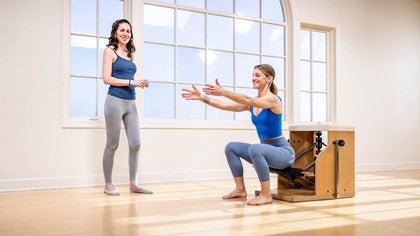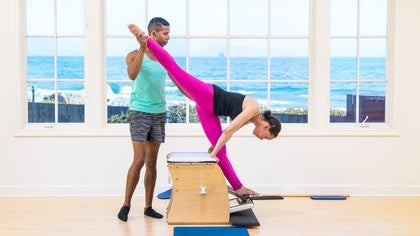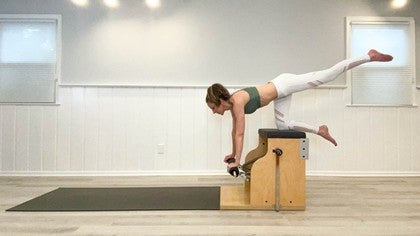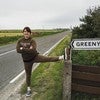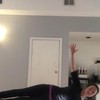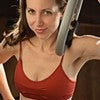Description
About This Video
Transcript
Read Full Transcript
So we're working on strength training exercises, that you would normally see more in a gym done on Pilates equipment. So we're gonna do the chair today. So I have Kathleen with me, and she's, already done as some squats. To warm up because we're gonna be doing some more squats. So in this strength series, we do not have like a big warm up worked in like we would in maybe a more traditional Pilates class.
So if you feel like you need to warm up before you jump into something a little bit more extreme, then go ahead and do that and meet us back here. We currently have 2 springs on. She's pretty light, so we have 2 on 2, and we're gonna do some squats. I did this in a, a earlier chair class on Pilates anytime because I really like it. I think it's fun, so we're gonna do it again. So go ahead and you're gonna face towards that wall with your heels.
Back towards not too far towards the platform. Like, you wanna be, like, a little bit away. And the first thing we have to do is figure out where the pedal is because we're gonna do a little hip hinge squat which means flat back, butt goes back, you hip hinge, your arms go forward, you're looking for the pedal, and then stand yourself back up. I think scoop back a teensy bit. Perfect. And let's try that again. So we're gonna squat down.
So you're finding that hip hinge, And then once you find it, you're gonna take your shoulders back some and then ride the pedal down. And then we're gonna come back up, and then you have to reverse what you did to come out of it. So it's shifting your weight forward and then standing back up. And then if that doesn't feel right, then you just kinda play around with your position until you find the position that is your sweet spot. So, again, your hip hinging finding the pedal, and then carry the pedal down. And what's fun about this is if you have the flexibility, you can go all the way to the floor And the pedal still helps you come all the way back up. Now if you're like me and you don't have the ability to door c flex as much, so if you have really tight calves, you can do something like put your, heels on something like slightly elevated, and you will be able to get this low, or you'll be able to bring your feet more forward in which case, you wanna add more weight to make it a little bit easier to come back up. We're gonna do one more like this just because these are fun. Good.
And then you're gonna travel down, lift back up, and then you're gonna come all the way back up to standing. So I'm gonna take one spring off for her. If you are managing your own chair, you're gonna probably want to lose one spring. And we're gonna do a reverse step back. So it's one spring on 2 for her. So spin yourself around. You probably want to figure out where your foot is going to be first.
I need something to hold on to in this exercise. If you don't have the best balance, grab something to hold on to, as well. So you want the ball of your foot reaching back on the pedal behind you to the extent that you can push the pedal all the way down to the floor. Tall through your spine, crown of your head reaching up towards the ceiling, and then you're gonna bend the pedal leg, letting the pedal lift up, and then you're gonna press the pedal back down towards the floor. So we're just gonna do four of these. And I have another exercise that if the weight was perfect, I would go right into it, but we we know we played around earlier.
That it needs to be a little bit heavier for her. So we're gonna switch legs before we do the second exercise. So go ahead and step your right foot down. And then step your left foot up. I think probably of any piece of apparatus, the chair is the most particular for each person. It's like, I don't know what the spring weight is ever.
It's you put a spring on, you push it down. Does it feel right? Yes. Does it feel right? No. If it doesn't feel right, you add, you take away, and then you do the size, if it doesn't feel right, you add or you take away. And then you eventually hit your your measurements where you kind of know, but then it just might be a day.
And then you might need less or more. Go ahead and come up. Good. And then we're gonna do an exercise that no one in the world likes a Bulgarian split squad variation. So a Bulgarian split squad is usually done on, like, a weight bench. So on the weight bench, you would be one foot's on the floor, one foot's back on the weight bench. Both legs have a little bit of pressure in them, so you're gonna feel both quads working. Now, because we have the pedal and the pedal moves, we're going to celebrate the fact that the pedal moves by letting the pedal move, but you still wanna have that pressure down into the pedal at the same time as you're doing the exercise.
On this one, you were gonna be wanna be further away than you were on the last exercise. So stepping back holding on to something if you need to, top of your foot on, kind of get your pelvis sorted to the front, and then you're gonna lower down. And it's very natural for in these exercises people to have a hip hike up on one side. So I always think about taking the side if you had your hands on your ASIS. And you felt like one side was going down.
Think about that the side that's going down. Think about that inner thigh and that leg just plugging up into your hip socket, and a lot of times that will fix it. So I probably think it's a little bit harder to do it this way than it would be to do on, a bench because of the pedal moving. Then we can go ahead and switch. And currently, she's very stiff in her upper body, which is a thing that we do when we're feeling like we have less control in a movement.
But if you wanna sort of shake out your arms a little bit, finding something to look at and move below the thing that you're looking and then move above the thing that you're looking at, I find sometimes lets your upper body find a little bit more ease than maybe it was finding previously. Let's do one more like this. Nice. Step your foot off. And then spin yourself around, and we're gonna do some push ups.
We're gonna do incline push ups because incline push ups are the easiest of all of them. So hands on the chair options. Flat hands, or I actually prefer hands out to the side because it's nicer for the wrists, walk your legs back, tuck your toes under, And then elbows bend as you lower your chest towards the chair and then press yourself way. And then lower down. Let's just do 6 of these pushing away, lowering down pushing away. And the beautiful thing about when you're doing incline push ups is you feel like you could just keep going forever.
Now we're gonna do some abs on the chair. So we're gonna do long It's not very long, but we're gonna do long as if we were doing abs on a weight bench. So instead of, like, laying down, we're not gonna be fully supine. You're gonna have hands behind you and you're gonna kind of prop yourself up and lean back. Bring your knees in towards your chest.
And we're gonna take your legs, move them away from you as you lean yourself further back. So you're shooting your legs out. Perfect. And then you're pulling yourself back in. So you get a little tricep work here as well, sending your legs away from you, and then pulling to come back in. And we can speed it up. So we're going out and pull out and pull. Nice.
Out. And pull out and pull now out, but not as far out. Open your legs, cross your legs, and then pull that in, and then we reach out and then switch the cross and pull that in. Or rolling out cross and pull out cross and pull, obviously, we can do 10,000,000 different variations of this similar exercise. What I like is it's sort of like it's getting a little bit of all of the abs and getting some triceps at the same time.
You don't feel like you're gonna fall off the chair quite as much as if you were laying down on it, in this position. Let's do one more here. And then you can go ahead and come off of that, and we're gonna come into a planche. So a planche is like a plank where you're just a little bit more forward of, shoulders over wrists. We have them all over the place in Pilates. So this is going to look like the Pilates push up where you just move the pedal, but our emphasis on moving the pedal is not to do a push up at this point.
It's just to travel our shoulders over our wrists. Now if you accidentally push the pedal all the way down, I have been there. You feel like it's sort of an emergency. Easiest way to get yourself out of it is just to like walk your weight back towards your feet with your hands. And then step one foot off and then let the pedals slowly lift. So, but since I'm here, if that happens to you, I'll step on the pedal and then save you that way. So go ahead and you wanna face away and then hand to the floor. And then I just have people get into this however they feel most comfortable.
And I find that whatever my first foot position is is always wrong. So you can always adjust as needed. So bring yourself into a plank. So in this plank, you wanna have your shoulders like, kind of in line with your wrists. And then as you bring begin to move forward, the pedal moves, but your shoulders are really the fulcrum or the point of movement. So you're moving forward and back.
Now if you wanted to make this harder, you could do exactly the same thing, and the only thing you change is that you start with your hands closer to the pedal. So that you're creating more and more and more of that shoulders over wrists sensation, which is hard. So we don't necessarily wanna do that. We're gonna call this sort of down dog position as a little bit of a break. If you wanna bring a foot down to the floor just to give yourself a bigger break, go ahead and do that.
And then we're gonna do this into sort of a walk back into a handstand l. Options are to use the pedal or to use the chair. Sometimes I like to use the chair because it doesn't move and the pedal moves. So begin to walk your hands back until your hands are underneath your hips, and hold yourself in that position. And then you can bring one leg up.
Nice. And we're not gonna do a full handstand here. And then you can go ahead and lower that down, and then you can bring the other leg up. And then we do sometimes run into the chair here. So if you feel like you're doing that, you can go ahead and just bend a knee in, foot down, foot down, slowly roll up, let yourself recover. So we're gonna let the blood flow throughout the rest of your body.
We actually have a bun of additional exercises that we're gonna use with the chair handles. And I'm also gonna be using, a pull up band So if you have the handles, that's awesome. You can go ahead and join us for that. If you don't have the handles, you just wanna check it out. You can hang around. Or move on with your day.
Okay. So for the rest of the exercises, we do not need a spring on the pedal. We're just gonna actually lower the pedal all the way to the floor. I'm sure this is not the way to do it. So, call the Pilates police and say, gonna lower it from the spring. And, I'll be here when they come pick me up. Go ahead and come towards the chair, and we're actually gonna stand on the pedal And we're gonna do a little variation of a type of squat called a sissy squat. So in a sissy squat, if you're really crazy strong, you can just, like, lean back and, like, lower your knees till you touch your knees to the floor and stand back up if I can do that.
We're gonna do this going into the seat. So we have the handles to hold on to. You're gonna lean back. You're trying to keep a straight line from your knees to your shoulders, going as low as you can go, where you can still make your way back up. We're gonna do five five seems like enough.
Good. Two more. I feel like I'm, like, sending my energy to her, like, just lean back forward lean back more. Nice. And then come all the way up. Great. Go ahead and you can step off for a second.
Just shake your legs out. This is a pull up band. You can buy them on Amazon. This is a Rogue band, that they're just like a weight lifting equipment they're basically these looped bands. They come in different weights.
The red one is like a really good one to have because it's very useful for a lot of different things. We're gonna use this here instead of doing pull ups. A lot of times, people will do a pull up and they'll, you know, hang this band on the bar and then they'll step in it. We're gonna step in it for tricep dips instead. And we're gonna pretend that this is not a chair that these are parallel bars which are seen a lot of times in gyms or even in gymnastics centers.
So the more band you throw over the handle, the heavier it is, the less the lighter it is, and then the thicker the bands, the heavier it is. So I'm gonna let you choose your own tightness, have it over the handles, and then you'll step up We're gonna do some shrugs and shoulder circles before we go into our dips. So you can step one foot on, push the band down, and then you're gonna let the band begin to lower and you're gonna bring your other foot in. So first thing is just shoulder shrugs. So shoulder shrugs first.
Let's keep it easier first. Good. Press down. Good shoulders by your ears, and then press down. If you feel like you're rubbing your shins too much in towards the chair, you can just basically push back a little bit. Yep. Perfect. And then we can take this into circles. So doing circles.
Nice. And you can do both directions. Would you like to take a break? Sure. Okay. Let's take a break. So you're gonna bring a foot up.
Step up. Take a break before we do the dips. So on the dips, normally, we would do dips on chair using the pedal. We still need to get an angle to go slightly back just so that we don't run into anything. You also have the option if it feels like scary to stand in it to have the strap on your knees.
I've definitely done it on my knees before where it's like your knees are in and you lower your knees to touch the chair and you push off, but we're gonna do the standing one because that's the one we practiced. And I know you can do it well. So step a foot into the band and then let that foot go off the chair, step the other foot into the band. So we still have that idea of that pushing away that we've already created legs back a smidge, bend your elbows, lowering down, and then let the band help lift you back up. Good lowering down, gorgeous, and lift back up.
Good lower down. And lift back up got one more. Lower down and lift back up. And then you can go ahead and step your foot out. Step your other foot out.
It is sometimes not fun when you accidentally let the band go because it does smack you pretty hard. So It's always a success when that doesn't happen. You can go ahead and slowly make your way off. And then we're just gonna give everything a shake for a second. We have one last exercise, which is still using those muscles that are gonna depress your shoulders, and we're gonna do We're gonna do bent knee first, and then we'll do an l sit, which is in the classical Pilates repertoire, but it fits well also into more of the strength training stuff. So you can really face whichever whichever way you want, and do you want the pedal to help on the way up?
Sure. Okay. So if you wanna go ahead and lift the pedal, and put it on in the proper way that I didn't put it on. So you just add some spring weight to it. And so in general, when we're doing l sits, we'd be facing this way. So we'll just do it sort of in the normal way, which you can sort of start as if you were doing a a dip facing pout. Okay. So coming up to the top first, And then once you get there, bend your knees so that the pedal catches at the top. We're gonna bring a knee in.
Bring a knee in. This is always the hardest part is you have to sort of get your lats involved to keep your shoulders back. Lower your feet down tap the pedal. And then lift back up just three, too, because these are really, really hard. And 3, and then see if you can do straight legs.
Hero shot. Just one. I only wanted 1, and then you could go ahead and lower all the way back down. The best part of this exercise is the end part of this exercise, which is where you turn around and hang off the, handles to stretch. Just be careful with the pedal. No reason to leave this out, even if this is sort of in more of the Let's just do a quick overview of things you can do on the chair. And then if there are any last stretches or anything that you wanna take, that makes sense for your body, go ahead and take those now.
And if you wanna see more ideas of using strength training techniques on Pilates equipment, there are more classes, in this series as well.
Wunda Chair Workouts: Advanced Wunda Chair Classes
Comments
You need to be a subscriber to post a comment.
Please Log In or Create an Account to start your free trial.
